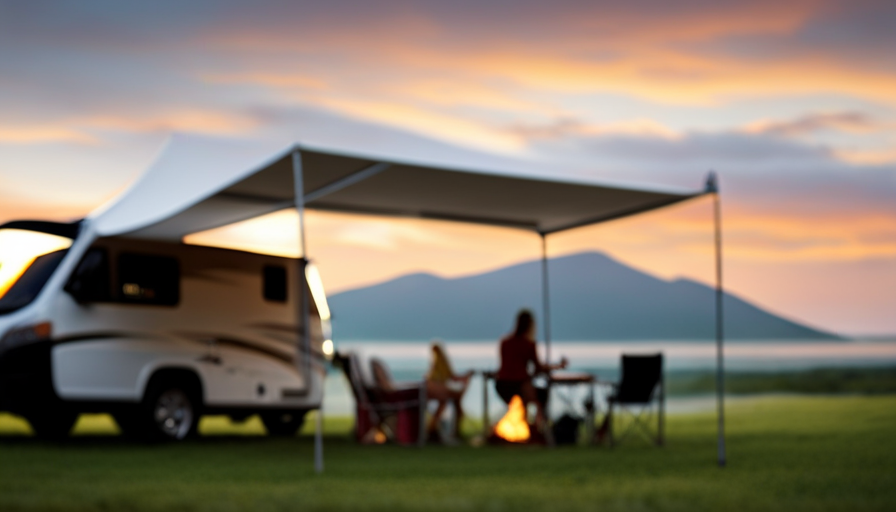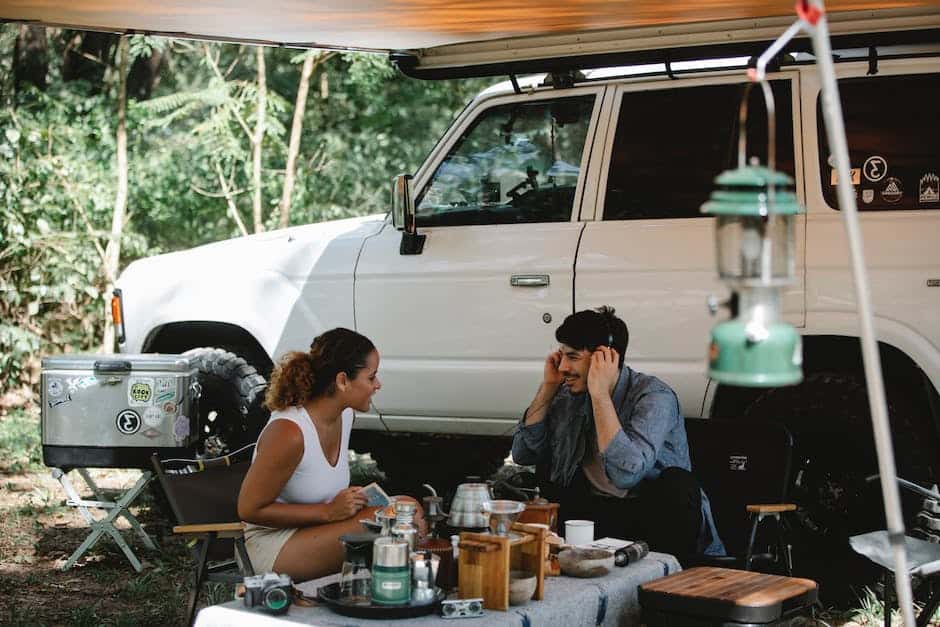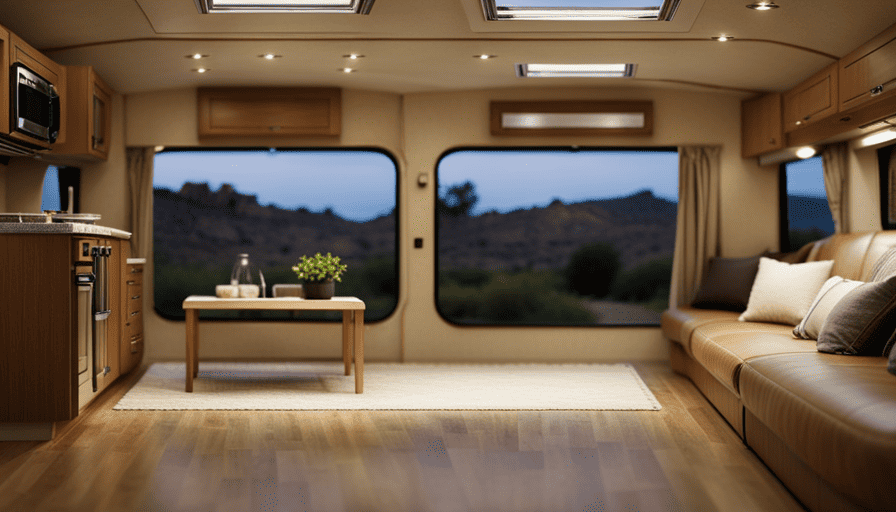Do you feel tired from being under the hot sun on your camping adventures? Are you looking for a shady spot to relax and enjoy the outdoors? I have the ideal solution for you!
In this article, I’m going to show you how to make your very own awning for your camper.
Picture this: You’re out in the wilderness, surrounded by beautiful scenery, but the sun is beating down on you relentlessly. You search for a shady spot to escape the heat, but there’s nowhere to hide. That’s where an awning comes in. With an awning, you can create a comfortable, shaded area right next to your camper, providing you with a cool and relaxing retreat.
Now, I know what you’re thinking – making an awning sounds complicated. But fear not! I’m here to guide you through the process, step by step. From assessing your awning needs to attaching it to your camper, I’ll provide you with all the knowledge and tips you need to create the perfect awning for your camping adventures.
So let’s get started and transform your camper into a shady oasis that you can enjoy all summer long!
Key Takeaways
- Assess awning needs and space around camper
- Choose waterproof and UV resistant fabric
- Install support poles or frames for stability
- Regularly clean awning with mild soap solution and rinse thoroughly
Assess Your Awning Needs and Space
Before you start, take a good look at your camper and think about how you want to use the awning and the space around it. Assessing your awning needs and space is crucial to ensure you choose the right design and installation techniques.
Consider the size of your camper and the amount of shade you desire. Are you looking for a small awning to cover just the entrance, or do you want a larger one that extends further out? Think about the activities you plan to do under the awning. Will you be dining, lounging, or storing equipment? This will help determine the dimensions and layout of your awning.
Next, examine the available space around your camper. Consider any obstacles such as trees, utility hook-ups, or neighboring campers. These factors may impact the placement and orientation of your awning. Additionally, think about the terrain you will be camping on. Will it be level or uneven? This will affect the stability and anchoring of your awning.
Once you have assessed your awning needs and space, you can move on to gathering the materials and tools required for the installation. By carefully considering these factors, you can ensure that your awning will meet your specific requirements and provide a comfortable and functional outdoor space for your camper.
Gather Materials and Tools
First off, grab all the stuff you’ll need, like a sturdy frame, waterproof fabric, and a trusty toolbox. Choosing the right fabric is crucial for a durable and long-lasting awning. Look for materials that are waterproof and UV resistant to protect against the elements. Common options include polyester, vinyl, or canvas. Assess the size of your camper and determine the amount of fabric you’ll need. Measure the dimensions of the space where the awning will be attached and add a few extra inches for seams and hems.
In addition to the fabric, you’ll need some essential tools and equipment to complete the project. A sewing machine or heavy-duty needle and thread will help you stitch the fabric together. Don’t forget to gather measuring tape, scissors, and pins for accurate cutting and securing. A drill and screws will be necessary for attaching the frame to your camper.
To provide a more visual representation of the materials and tools needed, refer to the table below:
| Materials | Tools | Equipment |
|---|---|---|
| Sturdy frame | Sewing machine | Measuring tape |
| Waterproof fabric | Heavy-duty needle and thread | Scissors |
| Toolbox | Drill | Pins |
| Screws |
With all the materials and tools gathered, you’re ready to move on to the next step of measuring and cutting the fabric to size.
[Transition sentence into the subsequent section about ‘measure and cut fabric to size.’]Measure and Cut Fabric to Size
Now that you’ve gathered all the necessary materials and tools, it’s time to get down to business and measure and cut the fabric to the perfect size for your new awning. Proper measuring techniques are crucial to ensure a snug fit and a professional-looking end result. Here’s how you can measure and cut the fabric for your camper awning:
-
Measure the width: Start by measuring the width of your camper’s roof where the awning will be attached. Make sure to account for any protrusions or obstructions.
-
Measure the length: Next, measure the desired length of your awning. Consider how much coverage you want and how far you want the awning to extend from the camper.
-
Choose the right fabric: When selecting the fabric for your awning, consider factors such as durability, weather resistance, and color options. Look for fabrics specifically designed for outdoor use, such as acrylic or vinyl-coated polyester.
-
Cut the fabric: Once you’ve measured the dimensions, use a sharp pair of fabric scissors to cut the fabric to size. Be precise to ensure a clean edge.
Now that you have your fabric cut to size, it’s time to create the necessary reinforcement for the awning.
Create Reinforcement for the Awning
Once you’ve measured and cut the fabric, it’s time to reinforce it to ensure durability and longevity. Reinforcement techniques are crucial to maintaining the strength of your awning and preventing any potential damage.
One effective method is to add grommets at regular intervals along the edges of the fabric. These grommets provide extra support and stability, allowing the awning to withstand strong winds and other weather conditions. To install the grommets, you’ll need a grommet tool and grommets that match the size of the holes you want to create. Simply follow the instructions provided with the tool to insert the grommets securely into the fabric.
Another technique is to sew reinforcing patches onto areas that may experience more stress, such as the corners or where the awning attaches to the camper. These patches can be made from a stronger fabric or even a few layers of the same fabric. By reinforcing these key areas, you enhance the overall awning durability.
Once you have completed the reinforcement process, you can move on to attaching the awning to your camper, ensuring a secure and long-lasting setup.
Attach the Awning to Your Camper
To securely fasten your awning to your camper, you’ll need to connect the reinforced fabric to the designated attachment points, ensuring a snug and dependable connection. Installing the awning securely is crucial to prevent any damage or accidents while on the road.
When it comes to choosing the right attachment method, you have a few options to consider. One popular attachment method is using awning rail. This is a metal or plastic track that’s mounted to the side of your camper. The reinforced fabric of the awning slides into the rail, providing a secure and stable connection.
Another option is using awning brackets, which are typically mounted on the camper’s wall. These brackets allow you to easily attach and detach the awning as needed.
Once you’ve chosen the attachment method that works best for you, carefully follow the manufacturer’s instructions to ensure proper installation. This will typically involve using screws or bolts to secure the attachment points. Remember to double-check that everything’s tightened securely before hitting the road.
Now that you’ve securely attached the awning to your camper, the next step is to install support poles or frames to provide stability and support.
Install Support Poles or Frames
One common concern people may have is the stability of their awning, but there’s a simple solution: installing support poles or frames. These provide additional support and ensure that your awning stays in place even during strong winds or heavy rain.
When installing support poles, it’s important to first select the right location. Look for a spot that is sturdy and can handle the weight and tension of the awning. Once you’ve found the perfect spot, you can start installing anchors to secure the poles. Make sure to use anchors that are suitable for the type of ground you’re working with, such as concrete or grass.
Next, you’ll need to select the right fabric for your awning. Choose a fabric that is durable, waterproof, and UV resistant. This will ensure that your awning can withstand the elements and last for a long time.
To emphasize the importance of these steps, I’ve created a table below:
| Step | Description |
|---|---|
| 1 | Select a sturdy location |
| 2 | Install anchors to secure poles |
| 3 | Choose a durable and waterproof fabric |
By following these steps, you can ensure that your awning is stable and secure. In the next section, we will discuss how to test and adjust the awning to make sure it is properly set up.
Test and Adjust the Awning
Now that you’ve installed support poles or frames, it’s time to put your awning to the test and make any necessary adjustments to ensure its proper setup. Here are some adjustment techniques you can use to make sure your awning is functioning correctly:
-
Check the tension: Start by making sure the fabric is taut and properly aligned with the poles or frames. Adjust the tension as needed to avoid sagging or excessive tightness.
-
Test the stability: Give your awning a gentle shake to see if it wobbles or feels unstable. If it does, you may need to reinforce the support poles or frames or add additional stabilizing elements.
Common mistakes to avoid when testing and adjusting your awning include:
-
Over-tightening: Applying too much tension to the fabric can cause it to rip or put unnecessary strain on the support structure.
-
Ignoring stability issues: If your awning feels unstable or wobbly, it’s important to address the issue before using it. Unstable awnings can be hazardous and may not provide adequate protection.
Now that you’ve tested and adjusted your awning, it’s time to add the finishing touches for style and functionality.
Add Finishing Touches for Style and Functionality
Enhance the appearance and usability of your awning by adding the final details for style and functionality. When it comes to choosing the right fabric for your camper awning, there are a few factors to consider. Firstly, opt for a durable and weather-resistant material such as acrylic or vinyl-coated polyester. These fabrics are resistant to fading, mildew, and tearing, ensuring a long-lasting awning. Additionally, consider the color and pattern of the fabric to match your camper’s aesthetic.
To add a personalized touch, consider incorporating decorative elements into your camper awning. This can include adding trim, such as fringe or piping, to the edges of the awning. Another option is to attach accessories like string lights or hanging plants to create a cozy and inviting atmosphere. Don’t forget to choose decorations that are easy to install and remove for convenience.
Incorporating a 2-column, 5-row table can provide a level of sophistication to your awning. Here’s an example:
| Decorative Elements | Pros |
|---|---|
| Fringe | Adds a playful touch to the awning |
| Piping | Provides a polished and refined look |
| String Lights | Creates a warm and inviting ambiance |
| Hanging Plants | Adds a touch of nature and freshness |
| Curtains | Offers privacy and shade |
By adding these finishing touches, you can create an awning that not only protects you from the elements but also adds style and personality to your camper. Now, let’s transition into the next section on how to maintain and clean your awning.
Maintain and Clean Your Awning
To keep your awning looking its best, it’s essential to regularly maintain and clean it, ensuring it stays in top-notch condition.
Here are some cleaning tips to help you effectively clean and prevent mold on your camper awning:
-
Use a mild soap solution: Mix a few drops of dish soap with warm water in a bucket. Dip a soft brush or sponge into the solution and gently scrub the awning, paying extra attention to any stained or dirty areas.
-
Rinse thoroughly: After scrubbing, rinse the awning with clean water to remove any soap residue. Use a hose or a pressure washer on a low setting to ensure a thorough rinse.
-
Allow it to dry completely: Once the awning is clean, let it air dry completely before retracting it. This will prevent mold and mildew from forming due to trapped moisture.
Regularly cleaning your awning will not only keep it looking great but will also help extend its lifespan. By following these cleaning tips, you can ensure that your awning remains in top condition for many camping adventures to come.
Now, let’s move on to the next section and learn how to enjoy your new camper awning!
Enjoy Your New Camper Awning!
Take full advantage of your brand new camper awning and savor every moment of outdoor bliss! Choosing the right awning fabric is crucial for long-lasting performance. Look for materials that are durable, waterproof, and resistant to fading from the sun’s harmful UV rays. Popular options include acrylic, vinyl, and polyester fabrics. Consider the climate you will be camping in and the level of maintenance required for each type of fabric.
To ensure optimal shade coverage, finding the best angle for your awning is essential. Start by setting up your camper on level ground. Extend the awning fully and adjust the height according to your preference. Observe any shadows created by nearby trees, buildings, or other obstructions. By adjusting the angle of the awning, you can maximize shade coverage during different times of the day.
To help you visualize the importance of choosing the right fabric and finding the best angle, refer to the table below:
| Fabric Type | Durability | Waterproof | UV Resistance |
|---|---|---|---|
| Acrylic | High | Yes | Excellent |
| Vinyl | Medium | Yes | Good |
| Polyester | Low | No | Fair |
By considering these factors and experimenting with different angles, you can enjoy the perfect shade and comfort provided by your new camper awning. Happy camping!
Frequently Asked Questions
How do I choose the right fabric for my camper awning?
Choosing fabric for a camper awning is crucial for durability and functionality. The best fabric options include polyester, acrylic, and vinyl. Polyester is lightweight and resistant to mildew, making it ideal for outdoor use.
Acrylic is breathable, fade-resistant, and offers excellent UV protection.
Vinyl is waterproof, easy to clean, and can withstand harsh weather conditions.
Consider your specific needs, such as weather resistance and ease of maintenance, when selecting the right fabric for your camper awning.
Can I use a regular sewing machine to sew the fabric for the awning?
Yes, you can use a regular sewing machine to sew the fabric for the awning, but it’s recommended to use a heavy-duty sewing machine. A regular sewing machine may not be able to handle the thickness and strength needed for the fabric used in camper awnings. However, if you don’t have access to a heavy-duty sewing machine, there are alternative methods for sewing the fabric, such as hand sewing or using a heavy-duty needle and thread with your regular sewing machine.
What type of reinforcement is needed for the awning and how should it be attached?
When it comes to reinforcing and attaching the awning for your camper, there are a few key things to consider. First, let’s talk about reinforcement types. The most common types used are webbing and grommets. Webbing provides strength and stability, while grommets allow for easy attachment.
As for attachment methods, you can use bungee cords, hooks, or even Velcro. Each method has its advantages, so choose the one that best suits your needs.
Now, let’s dive into how to make an awning for a camper.
Are there any specific guidelines for attaching the awning to a pop-up camper?
When attaching an awning to a pop-up camper, there are some specific guidelines to follow.
First, ensure that the camper has a designated area or rail for attaching the awning. This may require drilling or installing brackets.
Next, use strong and secure fasteners, such as bolts or screws, to attach the awning to the camper.
Be sure to evenly distribute the weight and tension of the awning to prevent any damage to the camper’s structure.
How do I properly clean and maintain my camper awning to ensure its longevity?
To properly clean and maintain your camper awning, there are several tips you should follow. First, remove any loose dirt or debris using a broom or brush.
Then, mix a mild detergent with water and gently scrub the awning using a soft bristle brush. Rinse thoroughly with water and allow it to air dry completely before retracting.
Additionally, to protect your camper awning from weather damage, consider applying a waterproofing spray or coating to keep it resistant to rain and UV rays.
Can I Include an Awning in My DIY Camper Trailer?
Adding an awning to your DIY camper trailer is a practical and cost-effective way to enhance its functionality and comfort. By making a camper trailer yourself, you have the flexibility to customize it according to your needs, and including an awning can offer shelter from the elements while expanding your living space. Whether it’s for creating a shaded outdoor lounge or protecting against rain, an awning is a valuable addition to your homemade camper trailer.
Conclusion
After following these steps, you’ll have a beautiful and functional awning for your camper.
It’s amazing how a simple addition like an awning can make a big difference in your camping experience. Did you know that studies have shown that having an awning on your camper can increase your outdoor living space by up to 30%? This means more room for relaxing, dining, and enjoying the great outdoors.
So go ahead, make your camper even better with a custom awning and start enjoying all the benefits it has to offer!










